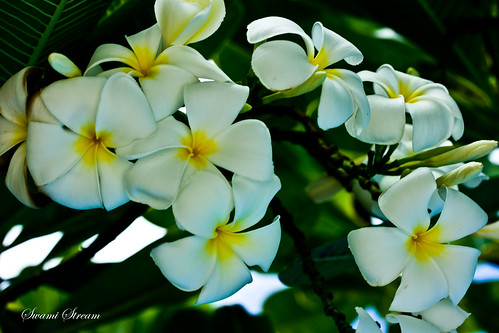Shot this near the Swimming Pool at Cosy Beach hotel in Pattaya. I have never seen such big frangipani before.
Plumeria is related to the Oleander, Nerium oleander, and both possess poisonous, milky sap, rather similar to that of Euphorbia. Each of the separate species of Plumeria bears differently shaped leaves and their form and growth habits are also distinct. The leaves of P. alba are quite narrow and corrugated, while leaves of P. pudica have an elongated oak shape and glossy, dark green color. P. pudica is one of the everblooming types with non-deciduous, evergreen leaves. Another species that retains leaves and flowers in winter is P. obtusa; though its common name is "Singapore", it is originally from Colombia. Frangipani can also be found in Eastern Africa, where they are sometimes referred to in Swahili love poems.
The Frangipani or Frangipane ("Breadbreakers", from Italian frangere il pane) was a powerful Roman patrician clan in the Middle Ages. The family was typically Ghibelline in sympathy and thus often at odds with the papacy. During the twelfth century, the Frangipani were the chief adversaries of the Pierleoni family, whose cardinal Pietro was raised to the papacy as Anacletus II.
Plumeria flowers are most fragrant at night in order to lure sphinx moths to pollinate them. The flowers have no nectar, and simply dupe their pollinators. The moths inadvertently pollinate them by transferring pollen from flower to flower in their fruitless search for nectar.
"Plumeria" species are easily propagated by taking a cutting of leafless stem tips in Spring and allowing them to dry at the base before inserting them into soil. They are also propagated via tissue culture both from cuttings of freshly elongated stems and aseptically germinated seed.
More on http://en.wikipedia.org/wiki/Frangipani_family
Lighthouse in Pondycherry
11 years ago


0 comments:
Post a Comment